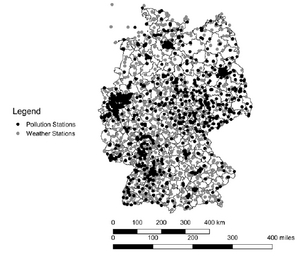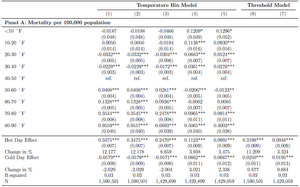Climate Change, Pollution and Human Health Outcomes
Climate Change, Pollution and Human Health Outcomes
Economists have shown a rapidly growing interest in the relationship between environment and health. The topic has gained increased relevance in recent years with emerging global climate change (e.g. warming temperatures and extreme weather events), but also due to new insights on the detriments of environmental pollution (e.g. water and air pollution, toxins). Yet the various pathways between environmental factors, human health, child development and labour productivity are not well understood. More research is needed in order to understand the causal pathways and to identify policy interventions suitable to enhance human health and social welfare.
Research:
In one of the ongoing projects we try to assess the short and medium-term impact of extreme temperatures on population health and health-related costs in Germany. For 1999 to 2008, we link the universe of 170 million hospital admissions and all 8 million deaths with weather and pollution data at the day-county level. Figure 1 shows the distribution of meteorological monitors which are scattered all over Germany and which collect weather information (e.g. temperature, humidity, precipitation and hours of sunshine) on a daily basis. The data are provided by the German Meteorological Service.
Figure 1: Distribution of Official German Ambient Weather and Pollution Monitors (Karlsson & Ziebarth, 2017).
Our findings suggest that extreme heat significantly and immediately increases hospitalisations and deaths whereas the results for extreme cold are less consistent. This result holds irrespective of whether we employ econometric models that are standard in the economics literature or models that are standard in epidemiology. Table 1 shows the effects on mortality using economics fixed effects models. We also find a clear age gradient in the hospitalisation and mortality pattern of extreme heat: mostly older people get hospitalised or die during heat events. However, maybe surprisingly, we do not find such age gradients when considering relative increases in percent, which tend to be roughly similar for all age groups.
Table 1: Temperature and Mortality: Economic Fixed Effects Models (Karlsson & Ziebarth, 2017).
Regarding health-related costs we estimate that one additional hot day with temperatures above 30°C causes monetised health losses of between €750 thousand to €5 million per 10 million residents, depending on the underlying assumptions.
Cooperations and funding:
The project is carried out in collaboration with Nicolas Ziebarth from Cornell University.
Publications and working papers:
Karlsson, Martin & Ziebarth, Nicolas R. 2017. “Population Health Effects and Health-Related Costs of Extreme Temperatures: Comprehensive Evidence from Germany.”
Karlsson, Martin & Schmitt, Maike, 2011. "Only in the heat of the moment? A study of the relationship between weather and mortality in Germany," Darmstadt Discussion Papers in Economics 203, Darmstadt University of Technology, Department of Law and Economics.
Ziebarth, Nicolas R. & Schmitt, Maike & Karlsson, Martin 2014. "The Short-Term Population Health Effects of Weather and Pollution: Implications of Climate Change," SOEPpapers on Multidisciplinary Panel Data Research 646, DIW Berlin, The German Socio-Economic Panel (SOEP).


